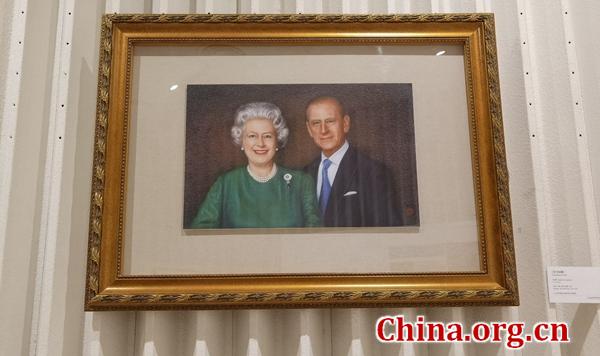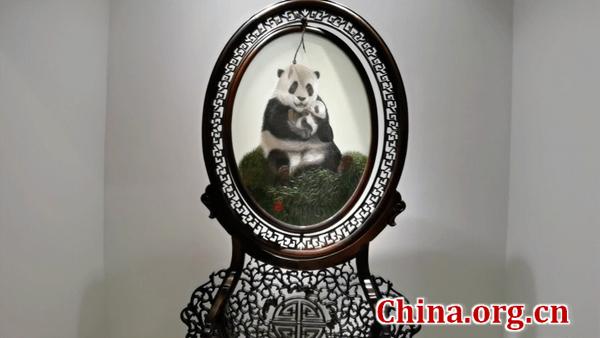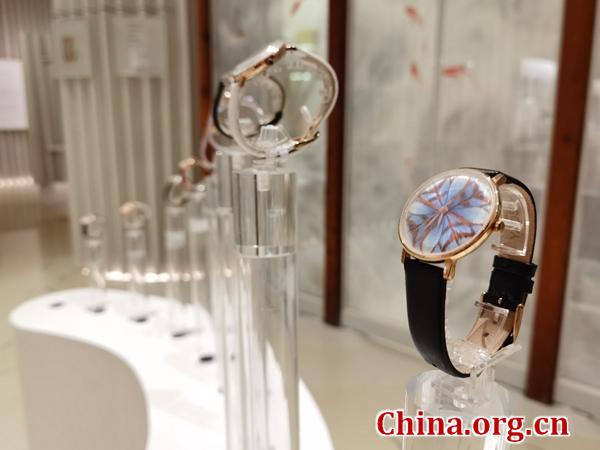Between the stitches: Inheritance and innovation of Suzhou embroidery
- By Wang Yiming
 0 Comment(s)
0 Comment(s) Print
Print E-mail China.org.cn, October 30, 2021
E-mail China.org.cn, October 30, 2021
Suzhou embroidery is one of the most celebrated styles of Chinese silk embroidery, named for the city of Suzhou in China's Jiangsu province. With a history of more than 2,000 years, this form of handicraft has earned a prestigious reputation globally for its variety of stitches, beautiful patterns, elegant colors, and consummate craftsmanship.
Suzhou-native artist Yao Jianping is one of the few inheritors of the national-level intangible cultural heritage of Suzhou embroidery. Many of her exquisite masterpieces have been given to foreign leaders as national gifts from China and collected in important institutions, including the Great Hall of the People, the National Museum of China, and Buckingham Palace.

Meanwhile, Yao Lan, an embroidery designer and Yao Jianping's daughter, has taken an innovative and modernized approach to the craft. She said she is committed to bringing this art form more into people's daily lives so as to promote the intangible cultural heritage that it embodies for a new generation.

High-end art collections and common-life decorations
"My mother founded the 'Embroidery Art of Yao Jianping' brand in 1998, mainly to create high-end Suzhou embroidery artwork for collections," Yao Lan said, noting that through decades of effort, Yao Jianping has been dedicated to passing on the Suzhou embroidery with her own innovations and artistic ideas, creating final artworks with high artistic merit.
"I believe that besides producing high-end art exhibits that serve a small number of people, embroidery can also be used in people's everyday lives, and novel products that meet modern tastes are also needed," Yao explained after being asked why she founded her own brand "Yao Silk" in 2010.
According to Yao Lan, "Yao Silk" seeks to create original products that integrate embroidery and patterns on earrings, watches, and scarves. Part of her mission is also to carry out aesthetic education and training so that more people can understand, appreciate, and purchase embroidery products.

The parallel development of these two brands is of great significance to hand down this intangible cultural heritage.
Currently, Yao's team consists of nearly 100 people, including some novices.
"Apprentices can start by creating some small products. Before, in fact, even three to five years of training would not ensure enough skill for an apprentice to be able to embroider a collectible artwork, which means that during this period, they would earn almost no money."
"But now, embroidering a small flower on an earring can bring them income," she said.
New ways of promotion and crossover cooperation
Yao's team has been exploring new ways to market and promote Suzhou embroidery online. A short video presenting Yao Jianping's embroidering of goldfishes went viral, garnering hundreds of thousands of views and likes.
A short video presenting Yao Jianping's embroidering of goldfishes posted on Chinese social media platforms. [Video courtesy of Yao's team]
Yao Lan's team was surprised by the popularity of the video, partly because it didn't feature the highest degree of Yao Jianping's skills, yet people were nonetheless effusive about the results.
"We realize that it is difficult for people to truly appreciate the beauty of Suzhou embroidery just by looking at pictures. In the new era of short videos, we should employ new promotional methods to allow people to feel the charm of this kind of art," Yao Lan said.
In addition to promoting via new media platforms, Yao's team is also actively engaged in crossover cooperation. Yao cited the cooperation with Tencent Games' role-playing online game "Kings of Glory," also known as "Honor of Kings," as an example.
Yao's team was invited to design a special cloth with embroidery, known as a skin, to adorn one of the in-game characters.
"The huge number of young players on 'Kings of Glory' may or may not have heard of Suzhou embroidery. Tencent holds the cutting-edge technologies to digitize our physical embroidery works well. So, we decided to cooperate and try to promote the embroidery in this way," Yao said.
The cooperation proved to be very successful, with the skin soon selling out when it was launched in August.
"The day after, a friend of mine brought her daughter to our team's studio to explore Suzhou embroidery. My friend told me that her daughter was unwilling to learn about the embroidery before, but this time had asked to come and visit the studio herself," Yao said.
"It made me realize that, instead of inculcating the concept of intangible cultural heritage, letting young people see and feel the embroidery in their surrounding environment is a better way to spark their curiosity and learn to appreciate it on their own accord."
Yao Lan noted that compared with previous days, when they only need to serve a small number of collectors, the team is now facing greater challenges, including quality control and providing after-sales service brought about by expanded business.
"But the passing on of intangible cultural heritage requires exploration, market-oriented approach, and new ways of promotion," Yao added.






Go to Forum >>0 Comment(s)